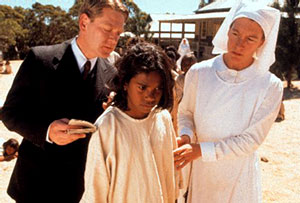
MELBOURNE, Australia (IPS) – Aboriginal communities in Australia are still mourning family ties destroyed by the forced removal of Indigenous children from their families–a tragedy for which the country’s prime minister has refused to apologize.
One decade ago, a landmark report called “Bringing Them Home” described the plight of the many children who were forcibly removed. These days, the situation of the “Stolen Generations” remains desperate.
Eugene Lovett grew up on a mission in Victoria state’s southwestern districts. He was removed from his family at the age of 3, along with a sibling, and placed in an orphanage in Melbourne.
“My family remained in contact with us over the years and tried to get us home, but the authorities wouldn’t let us go back to our parents,” Mr. Lovett said at a rally in Melbourne on “National Sorry Day,” which is held annually on May 26 to commemorate the atrocity.
Mr. Lovett said he still feels bitter. “It’s good to see all the people rally and support the Sorry Day march and what it represents. But for me, really, it’s nothing, because we’ve already lost our lives. Everything has been taken away from us,” he said.
Released in 1997, the report by the “National Inquiry into the Separation of Aboriginal and Torres Strait Islander Children from Their Families” acknowledged that Indigenous children were “forcibly separated from their families and communities since the very first days of the European occupation.” It was unable, however, to give an estimate of how many children were taken away.
The federal government has implemented only two of the 54 recommendations issued in the report, said Lyn Austin, chairwoman of Stolen Generations Victoria. “Are they going to wait another 10 years to implement the other 52 recommendations?” she asked.
In December 1997, the Australian government responded to the Bringing Them Home Report by providing 63 million Australian dollars (US$5.7 million) to pay for family support, culture and language maintenance, and to establish a national network of family link-up services to assist individuals. An additional 54 million Australian dollars (US$45 million) was pledged between 2002 and 2006.
A study evaluating the government’s programs was released in May. It found that these programs–designed to improve the social and emotional well being of Aboriginal Australians–provided services to large numbers of Aborigines, with generally high levels of client satisfaction for most of the services offered.
But the study also indicated several limitations, including a lack of focus on the first generation of Stolen Generation members, a lack of national consistency in service delivery, and significant levels of variation in the skills and qualifications of the staff members responsible for implementing some of the programs.
While Tony Abbott, the Australian health minister, has welcomed what he calls “positive outcomes” for Indigenous Australians, critics say figures from recent studies highlight the massive gaps in health between the Indigenous and non-Indigenous populations.
A joint paper from the National Aboriginal Community Controlled Health Organization and Oxfam Australia, released in April, shows discrepancies in key health indicators. Life expectancy for Aboriginal and Torres Strait Islander men is 56 years, and 63 years for women. These life expectancies are noticeably lower than the estimated lifespan of 76.6 years for men and 82 years for women from the non-Indigenous population.
The paper also shows that the life expectancies for Indigenous Australian men is, on average, more than 12 years less than the Indigenous populations in New Zealand, Canada and the U.S., while for women the difference is more than 11 years.
Chronic disease is much more common among Australia’s Indigenous population compared to the non-Indigenous population. Social and economic disadvantage, poor nutrition and lack of access to health care are among the major factors responsible for this gap.
The infant mortality rate for Indigenous Australians is 14.3 per thousand live births, three times that of non-Indigenous infants.
Robbie Thorpe, who led protests for Aboriginal rights during the 2006 Commonwealth Games in Melbourne, said the removal of Indigenous children from their families is just one part of the overall ill-treatment suffered by Aborigines.
“There is a criminal act of genocide continuing in this country. Stealing our children is one element of it. Destroying our land, massacring our people, killing us in jail, you name it. We’ve suffered all the crimes they can possibly commit against us,” Thorpe said.
Aboriginal filmmaker and musician, Richard Franklin, whose sister was removed from his family, called for Australians to acknowledge what Aborigines have endured. “We, as a nation, need to mature. And to mature, we must visit the past and recognize it for what it really was. We need to plant seeds in the present for future generations, for our children. Our children need to grow up together, Black and White,” he said.
Melissa Brickell, chairwoman of the Stolen Generations Victoria Sorry Day Committee, said Prime Minister John Howard–who controversially refuses to apologize, instead expressing “deep and sincere regret”–is not acting in accordance with the general population’s wishes.
“All the people in Australia support the Stolen Generations and the Aboriginal community toward justice on this [apology] issue. They walked, they talked, they collaborated, they developed partnerships–[PM] Howard just doesn’t get it. He doesn’t get what the people want,” Ms. Brickell said.
For Stolen Generations members such as Eugene Lovett, an apology from the government and improvements in Aboriginal health will not return what was taken away. “The damage has been done,” he said. “We haven’t got our parents here anymore. They had to suffer–it wasn’t only us who suffered.”












